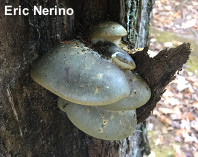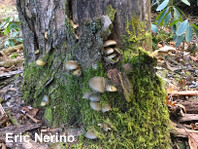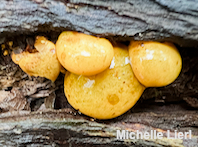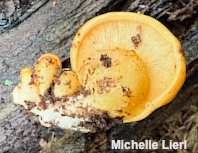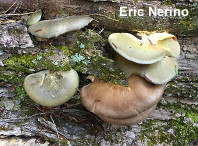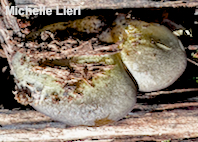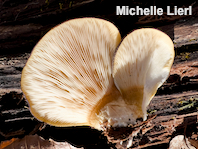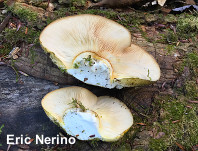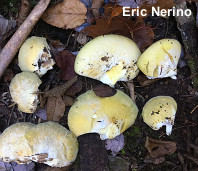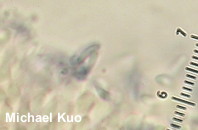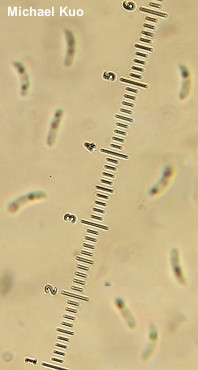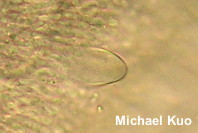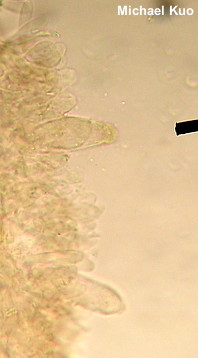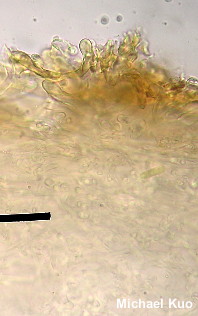| Major Groups > Gilled Mushrooms > Pale-Spored > Pleurotoid Mushrooms > Panellus serotinus |

|
[ Basidiomycota > Agaricales > Mycenaceae > Panellus ... ] Panellus serotinus by Michael Kuo, 6 June 2024 Panellus serotinus is, in the words of American mycological giant Alexander Smith, "the harbinger of the end of the mushroom season in late fall or winter depending on the region" (1975). It appears on the deadwood of hardwoods, usually on logs with bark still attached, and is reminiscent of oyster mushrooms—except that oyster mushrooms aren't green. Other distinguishing features for Panellus serotinus include the sticky-when-fresh surface, the rubbery flesh, and the orangish to yellowish gills that develop brownish edges. Panellus serotinus is often yellow or orange when young, and when this is the case it can be confused with Phyllotopsis nidulans. However, the latter species has a dry and hairy cap surface, while the cap of Panellus serotinus is sticky and more or less bald, at least when young and orange. Over the years Panellus serotinus has been placed in various genera (including Pleurotus, Hohenbuehelia, Panus, and Sarcomyxa). A 2001 study based on morphology and DNA (Jin, Hughes & Petersen) supported the idea that the genus Panellus is, well, a hot mess requiring substantial revision, and that Sarcomyxa serotina may be the most appropriate name for Panellus serotinus. However, the name Sarcomyxa serotina has not yet been validly published. The first attempt, made by Karsten in 1891, "fails" to meet an absolutely ridiculous standard set by contemporary taxonomic code (see discussion below if you care)—while the second attempt, made by Papp in 2019, is officially valid but completely unscientific, having been made without peer review, online, without offering a shred of scientific support (see this page for further discussion). So we are left with "Panellus serotinus" until someone publishes the Sarcomyxa combination responsibly. Thanks to Eric Nerino and Michelle Lierl for collecting, documenting, and preserving Panellus serotinus for study; their collections are deposited in The Herbarium of Michael Kuo. Description: Ecology: Saprobic on the recently downed (with bark still adnate) deadwood of hardwoods and occasionally on the deadwood of hemlocks; causing a white rot; usually growing in shelving clusters but sometimes growing alone or scattered; late fall and winter; originally described from Göttingen, Germany (Persoon 1793); widespread in Europe and North America, primarily in northern and montane (including Appalachian) areas. The illustrated and described collections are from Kentucky and Pennsylvania. Cap: 2–11 cm wide; semicircular to shell-shaped in outline; planoconvex to flat or shallowly depressed; sticky when fresh; bald or, with age, finely fibrillose-scaly, especially toward the point of atachment; at first orangish yellow to orange, becoming olive to dark green, sometimes mottled with yellow shades; fading to yellowish or greenish, or sometimes darkening to medium brown. Gills: Radiating from the point of attachment or running down the stem; close or crowded; often forking; short-gills frequent; orangish to yellowish buff, developing brownish edges. Stem: Absent or, when present (usually in younger specimens), lateral and stubby; whitish to yellowish or orange; often featuring a zone of small reddish brown potholes below the gills. Flesh: Whitish; tough and rubbery; unchanging when sliced. Odor and Taste: Not distinctive. Chemical Reactions: KOH on cap surface negative; ammonia on cap surface negative. Spore Print: White. Microscopic Features: Spores 3.5–5.5 x 0.75–1.5 µm; cylindric to suballantoid; smooth; hyaline in KOH, with 1–4 oil droplets; inamyloid, or with amyloid walls when still attached to (or recently released from) basidia. Basidia 25–28 x 3 µm; subclavate; 4-sterigmate. Cheilocystidia 35–60 x 7.5–15 µm; cylindric to fusiform or lageniform; smooth or encrusted; thin-walled; hyaline in KOH. Pleurocystidia 25–40 x 4–15 µm; fusiform to lageniform, widely cylindric, or subutriform; smooth; thin-walled; hyaline in KOH. Pileipellis a cutis with areas of trichoderm-like, upright aggregations of elements; elements 2.5–10 µm wide, smooth; hyaline to yellowish in KOH; terminal cells with rounded or subclavate apices. Subcutis gelatinized and poorly defined. Clamp connections present. REFERENCES: (C. H. Persoon, 1793) R. Kühner, 1950. (Fries, 1821; Kummer, 1871; Saccardo, 1887; Miller, 1970; Smith, 1975; Smith, Smith & Weber, 1979; Phillips, 1981; Arora, 1986; Breitenbach & Kränzlin, 1991; Phillips, 1991/2005; Schalkwijk-Barendsen, 1991; Lincoff, 1992; Vellinga, 1995; Barron, 1999; Jin, Hughes & Petersen, 2001; Roody, 2003; Miller & Miller, 2006; Binion et al., 2008; Boccardo et al., 2008; Buczacki et al, 2013; Siegel & Schwarz, 2016; Baroni, 2017; Gminder & Böhning, 2017; Elborne & Læssøe, 2018; Elliott & Stephenson, 2018; Sturgeon, 2018; Læssøe & Petersen, 2019; Kibby, 2020; McKnight et al., 2021.) Herb. Kuo 11131601, 10292301. Note regarding Sarcomyxa serotina P. Karst.: Karsten's 1891 combination fails to comply with Article 35.2 of the Melbourne Code, which says a combination is not valid "unless the author definitely associates the final epithet with the name of the genus." What Karsten did was to describe a new genus, Sarcomyxa, and then write, on the next line, "Type species: Pleurotus serotinus." He didn't write "Sarcomyxa serotina" because it was obvious what he was doing, and he wanted to be sure his readers knew precisely which fungus he wanted to be the type species for his new genus; thus he used the name that had been in use until then. But the code, approved 120 years later, demands the author actually write "Sarcomyxa serotina," and the blowhards in charge even offer an example of the "error" ("Ex. 6") which is fairly precisely parallel to Karsten's case. Meanwhile, the Code says, Linnaeus was not breaking the rules when he placed "the epithet in the margin opposite the name of the genus," since that strategy is more clear. Oh. Okay, Code Masters. This site contains no information about the edibility or toxicity of mushrooms. |
© MushroomExpert.Com |
|
Cite this page as: Kuo, M. (2024, June). Panellus serotinus. Retrieved from the MushroomExpert.Com Web site: http://www.mushroomexpert.com/panellus_serotinus.html |
